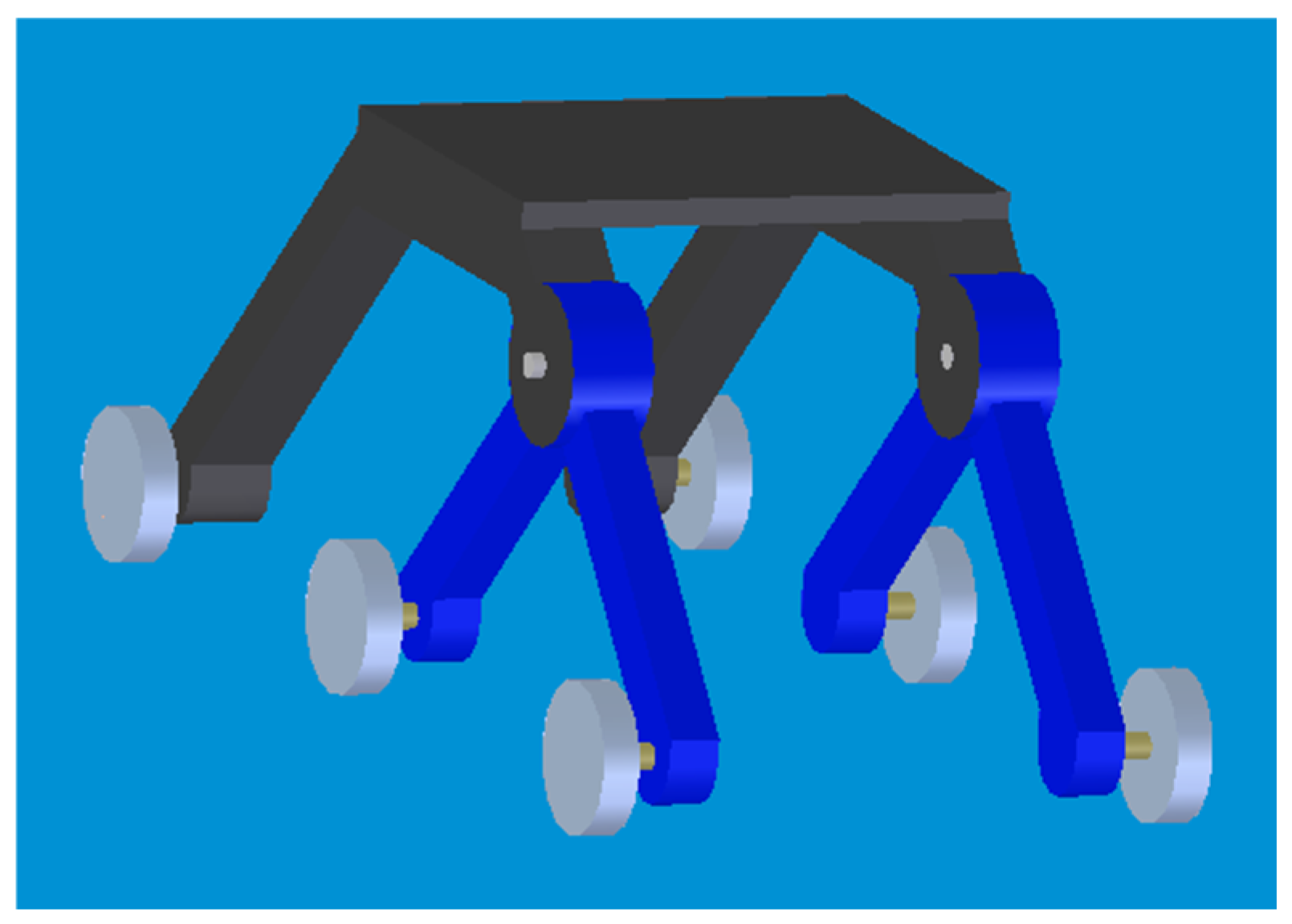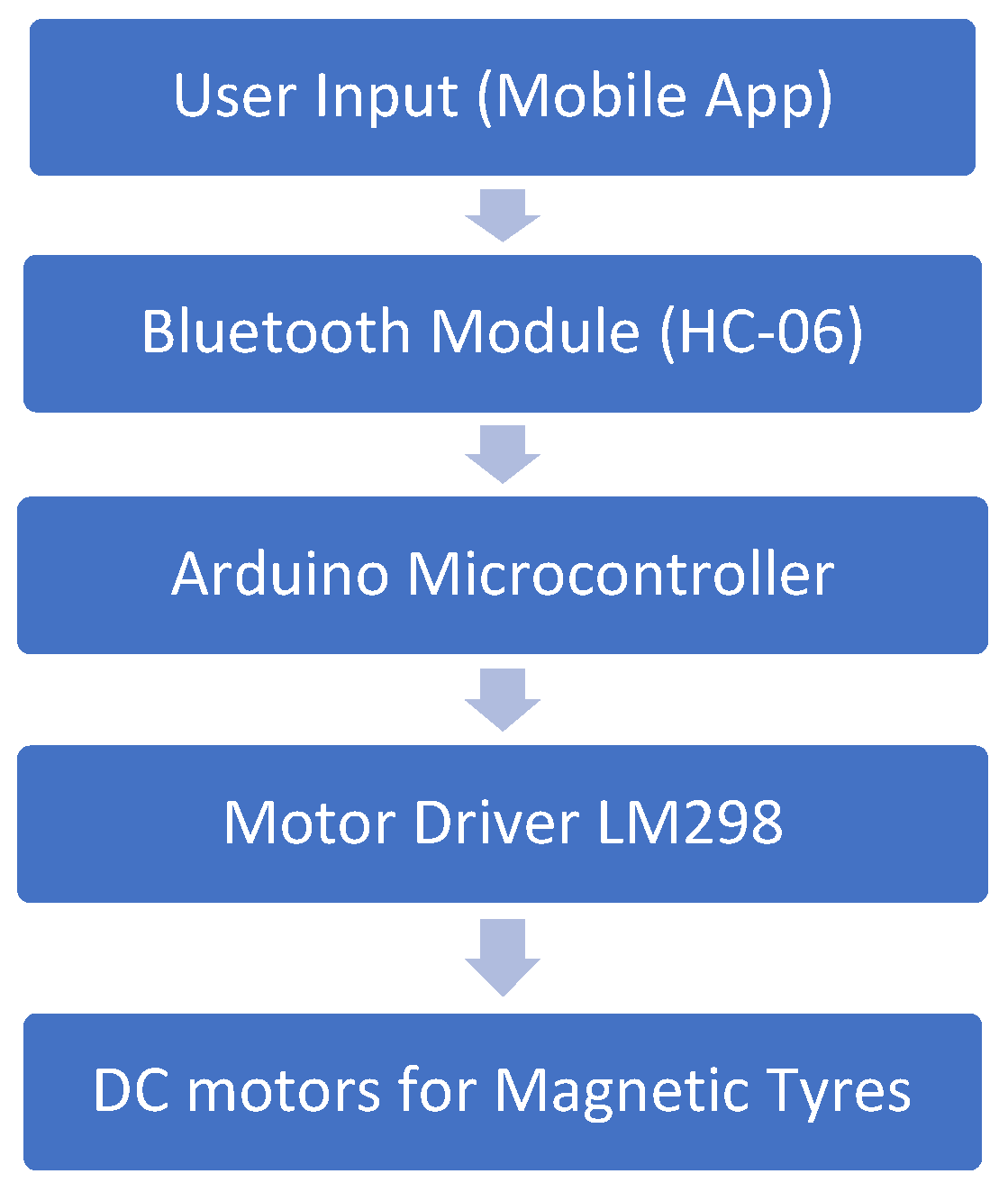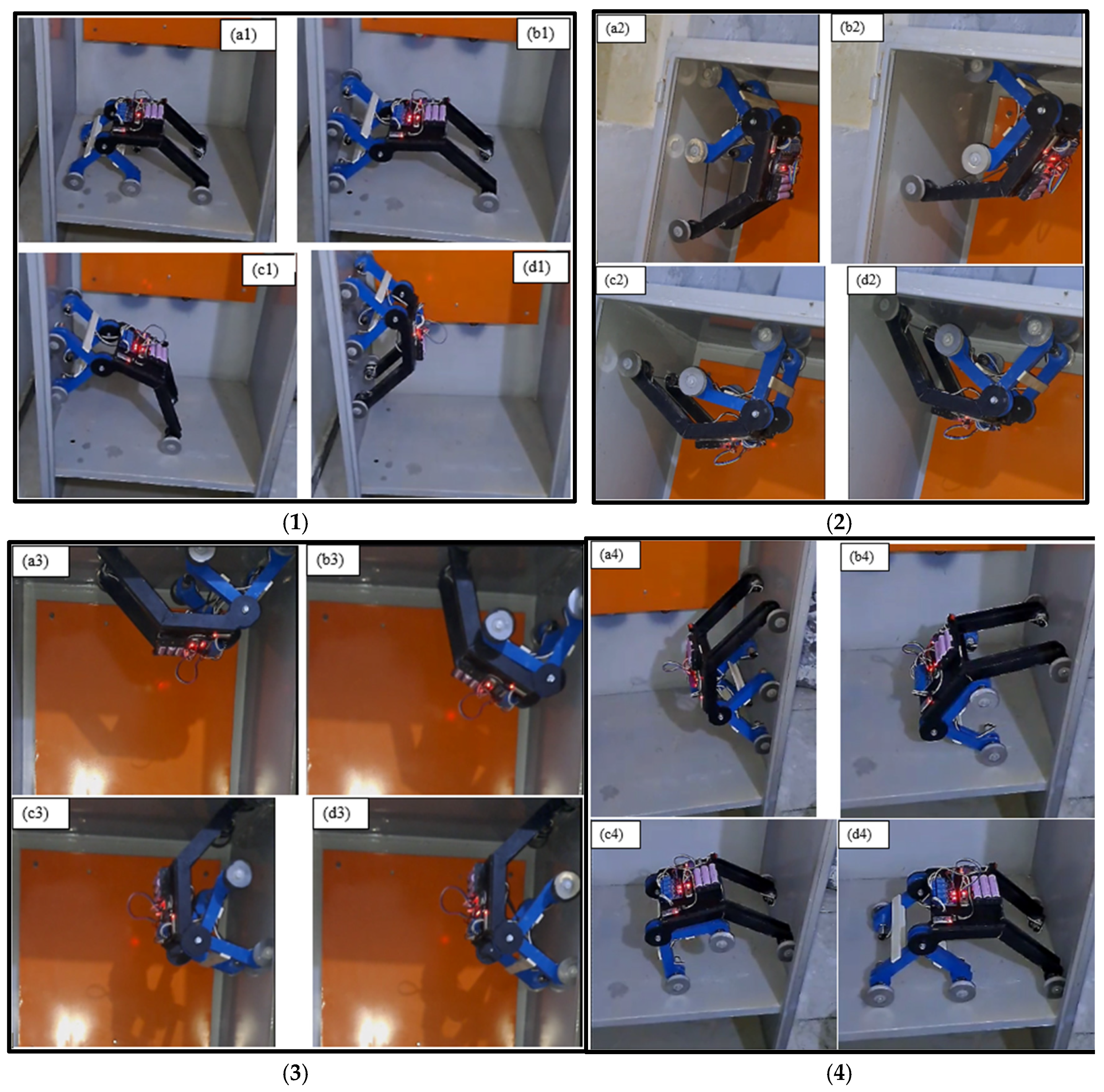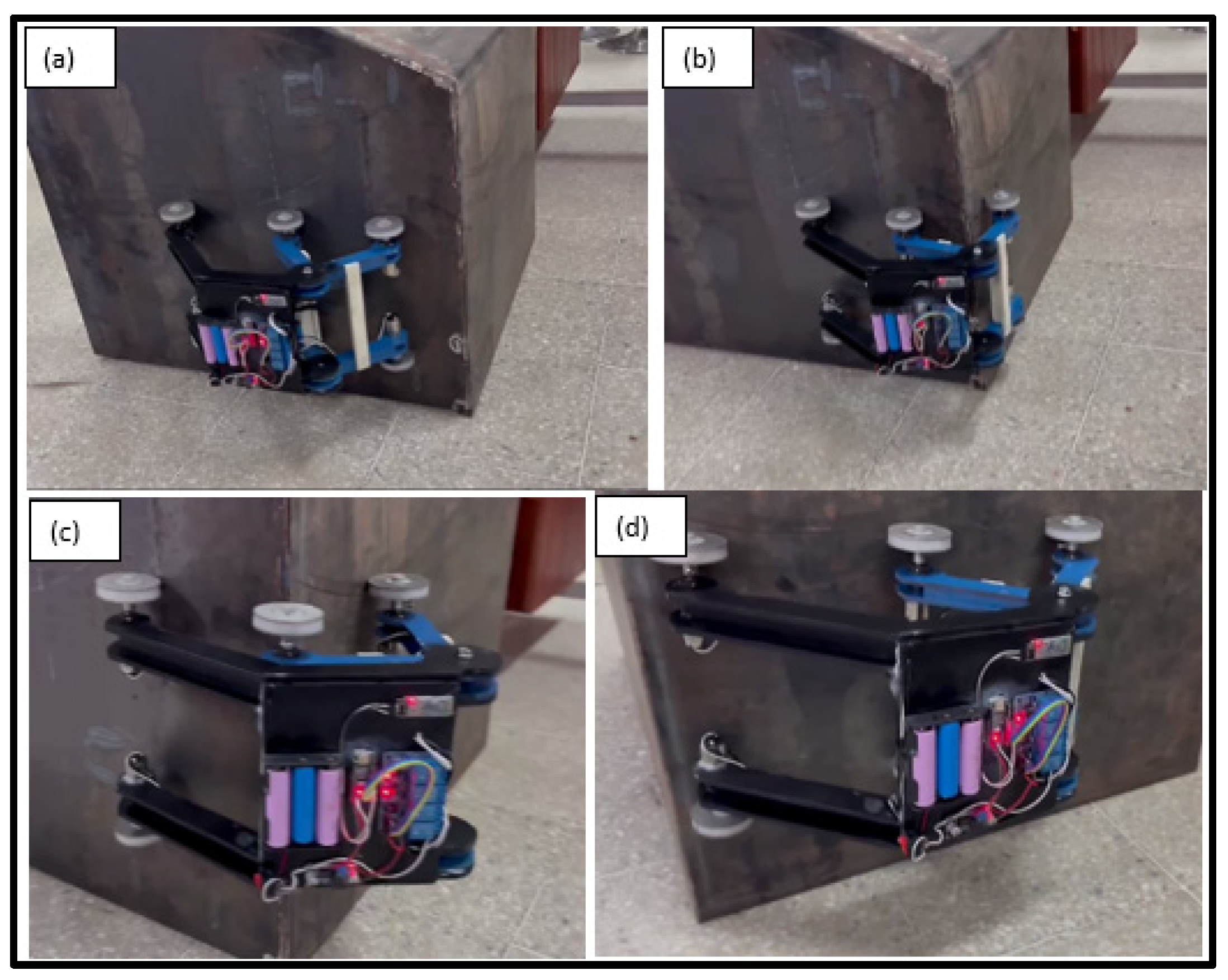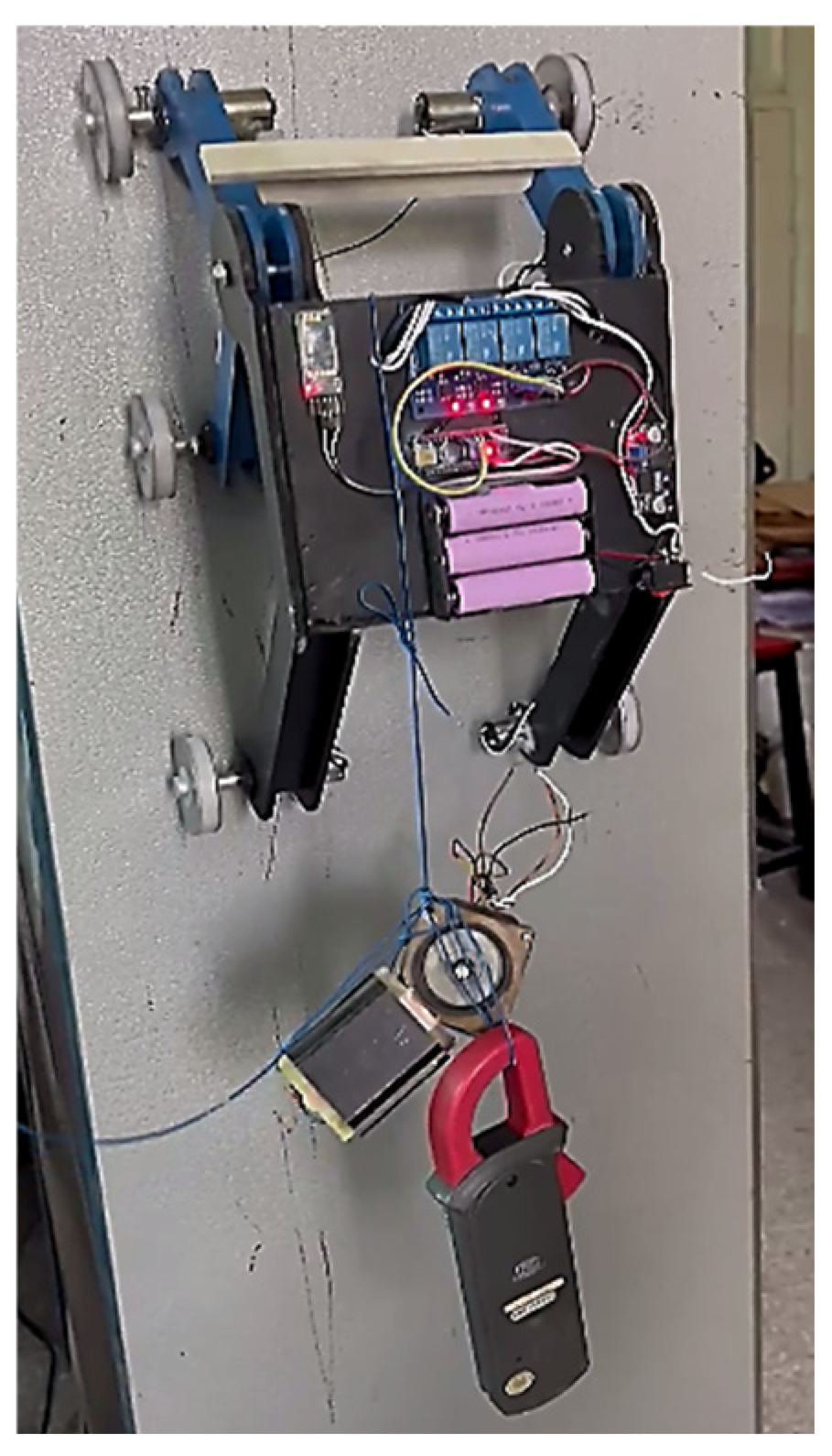1. Introduction
Robots have long been used as tools to extend human capabilities, reaching into places that are difficult to access by humans. Previously, humans were used to perform different tasks on high-rise buildings, towers, high walls, etc., which was dangerous for their safety and difficult to do [
1]. Wall-climbing robots are especially known for traveling on vertical and inverted surfaces, so they are useful in areas such as high-rise buildings, towers, boiler tubes, bridges, and dams for infrastructure inspection, maintenance work, and search-and-rescue [
1,
2,
3,
4]. Climbing robots with the capability of traveling on vertical surfaces and climbing from one surface to another are currently in significant demand. Robots with these capabilities would allow us to replace human workers in performing these dangerous tasks and would also eliminate expensive scaffolding and increase workers’ safety.
Wall-climbing robots have become a critical technology in various fields, including infrastructure inspection, search-and-rescue, and construction, due to their ability to navigate vertical and inverted surfaces. However, despite the progress they have made in adhesion and locomotion techniques designed for stable and smooth climbing on vertical structures [
5], a key challenge in their practical deployment remains the ability to perform smooth transitions between surfaces with different orientations. Depending on their operational objectives and design, robots employ a variety of locomotion techniques as shown in
Figure 1, which have a direct impact on how well they execute transitions. Wheeled mechanisms, tracked mechanisms, sliding frame mechanisms, and modular-type systems are examples of common locomotion. Alongside locomotion, the adhesion mechanism plays a crucial role in the robot’s overall performance. Various adhesion techniques have been developed for wall-climbing robots, including suction, magnetic, gecko-inspired, mechanical, electrostatic, chemical, pneumatic, and hybrid systems [
4,
6]. Each method has its own advantages and limitations depending on the surface type and application. Among these, magnetic adhesion is particularly suitable for metallic structures, which is the focus of this study.
Wall-climbing robots operated with magnetic adhesion have a vast array of industrial applications, owing to the huge number of metal structures made by human beings, for example, bridges, towers, ships, planes, silos, oil reservoirs, gas tanks, etc. WCRs with magnetic adhesion can climb metallic surfaces like boiler tubes, towers, ships, bridges, storage tanks, etc. [
7]. The main advantage of this method is that these robots do not need power for adhesion. The petroleum industry has a great number of potential applications for wall-climbing robots with magnetic adhesion, as they are investing significantly in reducing the inspection and maintenance cost of oil storage tanks. With the help of wall-climbing robots, they can easily perform inspection-related tasks as well as other tasks with minimal human involvement and less cost [
8].
In 2005, Shen et al. designed a wall-climbing robot for inspecting oil tanks with magnetic tracks [
9]. The robot utilized a permanent-magnet and tracked-wheel mechanism. The robots could carry weights of nearly 30 KG. After that, in 2006, Shen et al. developed a wall-climbing robot with a gecko tail to give extra support when moving from obstacles. The robot was used for the inspection of water tubes and oil tanks [
10]. Haruhiko Eto and H. Harry Asada (2020) developed a wheeled wall-climbing robot with a shape-adaptive magnetic adhesion mechanism [
11]. They developed a 2-degree-of-freedom rotational magnetic wheel system. The adhesion mechanism can change the direction of the magnets to keep the orientation of magnetic force always normal to the surface in contact.
Another wall-climbing robot was developed with magnetic adhesion techniques in 2017. The robot utilized permanent magnets for adhesion but with the addition of a non-contact adjustable adhesion mechanism, which calibrated the distance between the magnets and the metallic surface. It utilized a four-wheel locomotion system to move on the vertical surface and climb obstacles [
12]. Another climbing robot with magnetic adhesion was designed to facilitate cleaning and inspection issues in pressure vessels. They used a four-bar chain for locomotion, which gives forward and backward movement [
13].
Park et al. developed a configurable wall-climbing robot called R-Track. It stuck to the metallic surface with the help of magnetic tracks. Each module of R-Track can be connected or disconnected without any additional actuator. R-Track can perform various wall-to-wall transitions with the help of modular design [
5]. Another method for transitioning used by researchers is the track-wheeled mechanism. In 2011, Lee and Kim provided a high-payload climbing robot that changes the assembly of the robot according to the conditions of the external structures without feedback control. They used magnetic tracks to attach the robot onto steel walls. This robot has a payload capacity of 3 kg, compared to its mass of 4 kg. It can make 90-degree internal transitions but only 240-degree external transitions [
14]. They upgraded their robot in 2012 and presented a high-payload climbing and transitioning robot [
15].
Wall-climbing robots, as mentioned above, have certain advantages, but they also have disadvantages. With modular-type methods, the robots’ weight and overall cost increase significantly. Some robots need continuous power for adhesion purposes. Few robots are able to perform transitions at an angle greater than 90 degrees. So, we need to design a wall-climbing robot which addresses all these issues.
The existing locomotion and adhesion methods employed by wall-climbing robots for smooth operation are mostly power-dependent, complex, sensor-dependent, or require multiple actuators. In this study, we propose a novel and simplified transition system using a passive rocker-bogie mechanism with incorporated magnetic adhesion that can perform different transitions without the use of sensors or active balancing. This method reduces system complexity and power consumption, improves mechanical reliability and lowers cost.
This study addresses the following research questions:
- (1)
How can a wall-climbing robot achieve stable transitions using a rocker-bogie mechanism without any sensors?
- (2)
What is the maximum payload capacity of the robot without compromising mobility and stability?
- (3)
How will the robot behave during obstacle climbing?
By addressing these challenges, this study will assist in the development of more versatile, stable, and autonomous wall-climbing robots, expanding their usability in safety-critical inspection systems.
3. Experiments and Robot Performance
The design of the wall-climbing robot was subject to several practical limitations and several assumptions were made during testing to ensure practical testing in a controlled environment. The robot was constrained by several factors, including minimum possible weight for effective magnetic adhesion. It was built specifically for metallic surfaces and did not use any sensors, to reduce complexity and cost. Power, size, and weight limitations also affected the selection of compact and lightweight components. The robot was tested under the assumption of smooth metallic surfaces with no significant environmental impacts such as wind or vibrations. Also, it was assumed that the payload was static during operation and that the metallic structures did not have any effect on the Bluetooth signals.
A number of controlled trials were carried out on vertical steel surfaces with different surface conditions in order to verify the robot’s climbing abilities. A steel cabinet was used to conduct different experiments for all possible transitions available at one scholar’s home. The tests emphasized payload capacity and transition dependability for practical deployment. Performance was assessed using qualitative parameters such as stability, failure recovery, and success rate. The outcomes show that the robot can execute complex motions while ensuring steady adhesion, meeting its main design goals. We used a steel structure to test our robot and perform different transitions.
3.1. Internal Transitions
Four different internal transition sequences between vertical and horizontal surfaces were successfully performed by the robot. Throughout all directional changes, the magnetic wheels remained firmly in place, and the rocker-bogie mechanism seamlessly adapted to surface angles. Particularly stable transitions between parallel walls were the result of evenly distributed weight. The wall-climbing robot successfully and smoothly exhibited the different types of inner transitions, including ground to wall, wall to ceiling, and vice versa, as shown in
Figure 5.
3.2. Outer Transitions
The robot successfully executed critical external transitions on a steel cabinet: ground-to-wall, wall-to-ceiling, and ceiling-to-wall, as shown in
Figure 6. All transitions were performed smoothly without any loss of magnetic adhesion, demonstrating the system’s robustness in real-world scenarios. The rocker-bogie mechanism automatically adjusted wheel contact pressure during orientation changes, ensuring uninterrupted grip. The steel-reinforced magnetic tires maintained optimal flux concentration throughout, even during the challenging ceiling-to-wall descent. These tests confirm the robot’s capability to navigate complex structural geometries reliably, a key requirement for industrial inspection tasks.
3.3. Wall to Wall Transitions
Wall-to-wall transitions refer to the robot’s ability to seamlessly move from one vertical surface to another without losing adhesion or stability. This capability is crucial for robots designed to inspect or maintain structures like bridges, tanks, or high-rise buildings, where surfaces are often irregular or intersect at sharp angles. The robot’s ability to transition smoothly between walls relies on a combination of strong adhesion mechanisms and flexible locomotion strategies. By efficiently navigating from one wall to another as shown in
Figure 7, the robot ensures continuous operation without the need for human intervention, thus enhancing its autonomy and making it more effective in complex environments. This capability allows the robot to traverse large structures with minimal disruption and performs tasks like inspections or repairs at multiple points without requiring repositioning.
3.4. Obstacle Climbing
The wall-climbing robot showed reliable function and movement on the minor irregularities present on steel surfaces because of bolts, welding joints, etc. Its magnetic wheels remained in constant contact, even on irregular surfaces, because of the rocker-bogie mechanism. The robot was able to climb small obstacles of up to 20 mm as shown in
Figure 8 without losing grip. These tests demonstrate that this robot can perform efficiently on industrial structures with surface defects.
3.5. Payload Tests
Payload tests needed to be performed on the robot to ensure that the robot could carry different types of sensors and tools when required for inspection and maintenance. This property of the robot is critical to ensure that the robot can perform reliably and efficiently. Payload testing involves loading the robot with a certain weight and placing it in different scenarios to ensure that the robot can still function as required and maintain stability, mobility, and safety.
To test the robot’s performance under payload, we conducted progressive loading tests in a controlled manner. We used known weights to simulate the payload during tests as we did not have a calibrated force-measurement tool. A clamp meter weighing 220 g was first hung from the robot. It moved precisely and without any problems. The robot kept moving accurately when we added a 760 g stepper motor, ensuring its stability and functionality. After that we added a 580 g stepper motor, increasing the payload to 1.56 kg as shown in the
Figure 9.
When we increased the load from this point, the robot first moved a little but then it shut down and was disconnected. This failure happened due to the DC-geared motors exceeding their rated torque and current limits. The motors used more current to tackle the increased load, which triggered the protection mechanism, caused a voltage drop, and led to the shutdown of the system. Also, the robot’s system could have been put under increased pressure because a larger magnetic force is required to overcome increased weight.
The main output performance parameters for wall-climbing robots include payload capacity, transition capability, obstacle climbing and adhesion ability. Our robot was able to carry a maximum payload of 1.56 Kg and climbed obstacles of up to 20 mm while maintaining adhesion stability on vertical steel surfaces. The robot also performed different types of transitions on a variety of surfaces.


